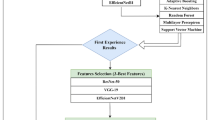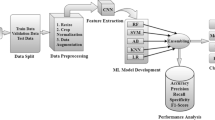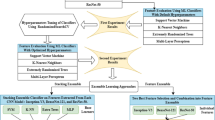Abstract
Brain tumors are one of the most dangerous health problems for adults and children in many countries. Any failure in the diagnosis of brain tumors may lead to shortening of human life. Accurate and timely diagnosis of brain tumors provides appropriate treatment to increase the patient's chances of survival. Due to the different characteristics of tumors, one of the challenging problems is the classification of three types of brain tumors. With the advent of deep learning (DL) models, three classes of brain tumor classification have been addressed. However, the accuracy of these methods requires significant improvements in brain image classification. The main goal of this article is to design a new method for classifying the three types of brain tumors with extremely high accuracy. In this paper, we propose a novel deep stacked ensemble model called "BMRI-NET" that can detect brain tumors from MR images with high accuracy and recall. The stacked ensemble proposed in this article adapts three pre-trained models, namely DenseNe201, ResNet152V2, and InceptionResNetV2, to improve the generalization capability. We combine decisions from the three models using the stacking technique to obtain final results that are much more accurate than individual models for detecting brain tumors. The efficacy of the proposed model is evaluated on the Figshare brain MRI dataset of three types of brain tumors consisting of 3064 images. The experimental results clearly highlight the robustness of the proposed BMRI-NET model by achieving an overall classification of 98.69% and an average recall, F1-score and MCC of 98.33%, 98.40, and 97.95%, respectively. The results indicate that the proposed BMRI-NET model is superior to existing methods and can assist healthcare professionals in the diagnosis of brain tumors.
Graphical Abstract









Similar content being viewed by others
References
Louis DN, Perry A, Reifenberger G, Von Deimling A, Figarella-Branger D, Cavenee WK et al (2016) The 2016 World Health Organization classification of tumors of the central nervous system: a summary. Acta Neuropathol 131(6):803–820. https://doi.org/10.1007/s00401-016-1545-1
Swati ZNK, Zhao Q, Kabir M, Ali F, Ali Z, Ahmed S et al (2019) Content-based brain tumor retrieval for MR images using transfer learning. IEEE Access 7:17809–17822. https://doi.org/10.1109/ACCESS.2019.2892455
Roy S, Meena T, Lim S-J (2022) Demystifying supervised learning in healthcare 4.0: A new reality of transforming diagnostic medicine. Diagnostics 12(10):2549. https://doi.org/10.3390/diagnostics12102549
Roy S, Shoghi KI (2019) Computer-aided tumor segmentation from T2-weighted MR images of patient-derived tumor xenografts. Image Analysis and Recognition: 16th International Conference, ICIAR 2019, Waterloo, ON, Canada, August 27–29, 2019, Proceedings, Part II 16: Springer; p. 159–71. https://doi.org/10.1007/978-3-030-27272-2_14
Pal D, Reddy PB, Roy S (2022) Attention UW-Net: A fully connected model for automatic segmentation and annotation of chest X-ray. Comput Biol Med 150:106083. https://doi.org/10.1016/j.compbiomed.2022.106083
Roy S, Bandyopadhyay SK (2016) A new method of brain tissues segmentation from MRI with accuracy estimation. Procedia Comput Sci 85:362–369. https://doi.org/10.1016/j.procs.2016.05.244
Wang Y, Wei X, Shen H, Ding L, Wan J (2020) Robust fusion for RGB-D tracking using CNN features. Appl Soft Comput 92:106302. https://doi.org/10.1016/j.asoc.2020.106302
Cheng J (2017) Brain tumor dataset. figshare Dataset 1512427(5)
Cheng J, Huang W, Cao S, Yang R, Yang W, Yun Z et al (2015) Correction: enhanced performance of brain tumor classification via tumor region augmentation and partition. PLoS ONE 10(12):e0144479. https://doi.org/10.1371/journal.pone.0140381
Seetha J, Raja SS (2018) Brain tumor classification using convolutional neural networks. Biomed Pharmacol J 11(3):1457. https://doi.org/10.13005/bpj/1511
Amin J, Sharif M, Yasmin M, Fernandes SL (2020) A distinctive approach in brain tumor detection and classification using MRI. Pattern Recogn Lett 139:118–127. https://doi.org/10.1016/j.patrec.2017.10.036
Gumaei A, Hassan MM, Hassan MR, Alelaiwi A, Fortino G (2019) A hybrid feature extraction method with regularized extreme learning machine for brain tumor classification. IEEE Access 7:36266–36273. https://doi.org/10.1109/ACCESS.2019.2904145
Zhou Y, Li Z, Zhu H, Chen C, Gao M, Xu K, et al (2018) Holistic brain tumor screening and classification based on densenet and recurrent neural network. International MICCAI Brainlesion Workshop: Springer; p. 208–17. https://doi.org/10.1007/978-3-030-11723-8_21
Sarhan AM (2020) Brain tumor classification in magnetic resonance images using deep learning and wavelet transform. J Biomed Sci Eng 13(06):102. https://doi.org/10.4236/jbise.2020.136010
Deepak S, Ameer P (2019) Brain tumor classification using deep CNN features via transfer learning. Comput Biol Med 111:103345. https://doi.org/10.1016/j.compbiomed.2019.103345
Kumar RL, Kakarla J, Isunuri BV, Singh M (2021) Multi-class brain tumor classification using residual network and global average pooling. Multimedia Tools Appl 80(9):13429–13438. https://doi.org/10.1007/s11042-020-10335-4
Anaraki AK, Ayati M, Kazemi F (2019) Magnetic resonance imaging-based brain tumor grades classification and grading via convolutional neural networks and genetic algorithms. Biocybernet Biomed Eng 39(1):63–74. https://doi.org/10.1016/j.bbe.2018.10.004
Noreen N, Palaniappan S, Qayyum A, Ahmad I, Alassafi MO (2021) Brain tumor classification based on fine-tuned models and the ensemble method. Comput Mater Continua 67(3):3967–3982. https://doi.org/10.32604/cmc.2021.014158
Badža MM, Barjaktarović MČ (2020) Classification of brain tumors from MRI images using a convolutional neural network. Appl Sci 10(6):1999. https://doi.org/10.3390/app10061999
Çinar A, Yildirim M (2020) Detection of tumors on brain MRI images using the hybrid convolutional neural network architecture. Med Hypotheses 139:109684. https://doi.org/10.1016/j.mehy.2020.109684
Talo M, Baloglu UB, Yıldırım Ö, Acharya UR (2019) Application of deep transfer learning for automated brain abnormality classification using MR images. Cogn Syst Res 54:176–188. https://doi.org/10.1016/j.cogsys.2018.12.007
Swati ZNK, Zhao Q, Kabir M, Ali F, Ali Z, Ahmed S et al (2019) Brain tumor classification for MR images using transfer learning and fine-tuning. Comput Med Imag Graph 75:34–46. https://doi.org/10.1016/j.compmedimag.2019.05.001
Alshayeji M, Al-Buloushi J, Ashkanani A, Se A (2021) Enhanced brain tumor classification using an optimized multi-layered convolutional neural network architecture. Multimedia Tools Appl 80(19):28897–28917. https://doi.org/10.1007/s11042-021-10927-8
Díaz-Pernas FJ, Martínez-Zarzuela M, Antón-Rodríguez M, González-Ortega D (2021) A deep learning approach for brain tumor classification and segmentation using a multiscale convolutional neural network. Healthcare: MDPI; p. 153. https://doi.org/10.3390/healthcare9020153
Gangopadhyay T, Halder S, Dasgupta P, Chatterjee K, Ganguly D, Sarkar S et al (2022) MTSE U-Net: An architecture for segmentation, and prediction of fetal brain and gestational age from MRI of brain. Network Model Analysis Health Inform Bioinform 11(1):50. https://doi.org/10.1007/s13721-022-00394-y
Anand I, Negi H, Kumar D, Mittal M, Kim T, Roy S (2021) Residual u-network for breast tumor segmentation from magnetic resonance images. Comput Mater Contin 67:3107–27. https://doi.org/10.32604/cmc.2021.014229
Asif S, Yi W, Ain QU, Hou J, Yi T, Si J (2022) Improving effectiveness of different deep transfer learning-based models for detecting brain tumors from MR images. IEEE Access 10:34716–34730. https://doi.org/10.1109/ACCESS.2022.3153306
Onan A, Korukoğlu S, Bulut H (2016) Ensemble of keyword extraction methods and classifiers in text classification. Expert Syst Appl 57:232–247. https://doi.org/10.1016/j.eswa.2016.03.045
Onan A, Korukoğlu S, Bulut H (2017) A hybrid ensemble pruning approach based on consensus clustering and multi-objective evolutionary algorithm for sentiment classification. Inf Process Manag 53(4):814–833. https://doi.org/10.1016/j.ipm.2017.02.008
Onan A (2018) An ensemble scheme based on language function analysis and feature engineering for text genre classification. J Inf Sci 44(1):28–47. https://doi.org/10.1177/0165551516677911
Onan A, Toçoğlu MA (2021) A term weighted neural language model and stacked bidirectional LSTM based framework for sarcasm identification. IEEE Access 9:7701–7722. https://doi.org/10.1109/ACCESS.2021.3049734
Onan A (2018) Biomedical text categorization based on ensemble pruning and optimized topic modelling. Comput Math Methods Med. https://doi.org/10.1155/2018/2497471
Onan A (2019) Consensus clustering-based undersampling approach to imbalanced learning. Scient Prog. https://doi.org/10.1155/2019/5901087
Onan A (2021) Sentiment analysis on product reviews based on weighted word embeddings and deep neural networks. Concurren Comput Pract Exper 33(23):e5909. https://doi.org/10.1002/cpe.5909
Onan A (2020) Mining opinions from instructor evaluation reviews: a deep learning approach. Comput Appl Eng Educ 28(1):117–138. https://doi.org/10.1002/cae.22179
Onan A (2021) Sentiment analysis on massive open online course evaluations: a text mining and deep learning approach. Comput Appl Eng Educ 29(3):572–589. https://doi.org/10.1002/cae.22253
Onan A, Korukoğlu S (2017) A feature selection model based on genetic rank aggregation for text sentiment classification. J Inf Sci 43(1):25–38. https://doi.org/10.1177/0165551515613226
Onan A (2019) Two-stage topic extraction model for bibliometric data analysis based on word embeddings and clustering. IEEE Access 7:145614–145633. https://doi.org/10.1109/ACCESS.2019.294591
Onan A (2019) Topic-enriched word embeddings for sarcasm identification. Software Engineering Methods in Intelligent Algorithms: Proceedings of 8th Computer Science On-line Conference 2019 Vol 1 8: Springer; p. 293–304. https://doi.org/10.1007/978-3-030-19807-7_29
Onan A (2022) Bidirectional convolutional recurrent neural network architecture with group-wise enhancement mechanism for text sentiment classification. J King Saud University Comput Inform Sci 34(5):2098–2117. https://doi.org/10.1016/j.jksuci.2022.02.025
Baltruschat IM, Nickisch H, Grass M, Knopp T, Saalbach A (2019) Comparison of deep learning approaches for multi-label chest X-ray classification. Sci Rep 9(1):1–10. https://doi.org/10.1038/s41598-019-42294-8
Christodoulidis S, Anthimopoulos M, Ebner L, Christe A, Mougiakakou S (2016) Multisource transfer learning with convolutional neural networks for lung pattern analysis. IEEE J Biomed Health Inform 21(1):76–84. https://doi.org/10.1109/JBHI.2016.2636929
Chollet F (2017) Xception: Deep learning with depthwise separable convolutions. Proceedings of the IEEE conference on computer vision and pattern recognition p. 1251–8. https://doi.org/10.1109/CVPR.2017.195
Simonyan K, Zisserman A (2014) Very deep convolutional networks for large-scale image recognition. arXiv preprint arXiv:14091556. https://doi.org/10.48550/arXiv.1409.1556
Huang G, Liu Z, Pleiss G, Van Der Maaten L, Weinberger K (2019) Convolutional networks with dense connectivity. IEEE Trans Pattern Anal Mach Intell 44(12):8704–8716. https://doi.org/10.1109/TPAMI.2019.2918284
He K, Zhang X, Ren S, Sun J (2016) Deep residual learning for image recognition. Proceedings of the IEEE conference on computer vision and pattern recognition. p. 770–8. https://doi.org/10.1109/CVPR.2016.90
Szegedy C, Ioffe S, Vanhoucke V, Alemi AA (2017) Inception-v4, inception-resnet and the impact of residual connections on learning. Thirty-first AAAI conference on artificial intelligence. https://doi.org/10.1609/aaai.v31i1.11231
Rosebrock A (2020) Finding extreme points in contours with OpenCV-PyImageSearch
Paul JS, Plassard AJ, Landman BA, Fabbri D (2017) Deep learning for brain tumor classification. Medical Imaging Biomedical Applications in Molecular, Structural, and Functional Imaging: SPIE. p. 253-68. https://doi.org/10.1117/12.2254195
Deepak S, Ameer P (2021) Automated categorization of brain tumor from mri using cnn features and svm. J Ambient Intell Humaniz Comput 12(8):8357–8369. https://doi.org/10.1007/s12652-020-02568-w
Ayadi W, Charfi I, Elhamzi W, Atri M (2020) Brain tumor classification based on hybrid approach. Visual Comput. https://doi.org/10.1007/s00371-020-02005-1
Kaplan K, Kaya Y, Kuncan M, Ertunç HM (2020) Brain tumor classification using modified local binary patterns (LBP) feature extraction methods. Med Hypotheses 139:109696. https://doi.org/10.1016/j.mehy.2020.109696
Bodapati JD, Shaik NS, Naralasetti V, Mundukur NB (2021) Joint training of two-channel deep neural network for brain tumor classification. SIViP 15(4):753–760. https://doi.org/10.1007/s11760-020-01793-2
Funding
This work was supported by the Natural Science Foundation of Hunan Province, China (Grant No. 2020JJ4757). This work is supported by the Intelligent annotation and fine-grained recognition of large-scale multimodal medical behavior belong to 2030 Innovation Megaprojects (to be fully launched by 2020)-New Generation Artificial Intelligence (Project no. 2020AAA0109600).
Author information
Authors and Affiliations
Corresponding authors
Ethics declarations
Conflict of interest
The authors declare that they have no conflict of interest.
Human and animal rights
This paper does not contain any studies with human participants or animals performed by any of the authors.
Informed consent
For this type of study, formal consent is not required.
Rights and permissions
Springer Nature or its licensor (e.g. a society or other partner) holds exclusive rights to this article under a publishing agreement with the author(s) or other rightsholder(s); author self-archiving of the accepted manuscript version of this article is solely governed by the terms of such publishing agreement and applicable law.
About this article
Cite this article
Asif, S., Zhao, M., Chen, X. et al. BMRI-NET: A Deep Stacked Ensemble Model for Multi-class Brain Tumor Classification from MRI Images. Interdiscip Sci Comput Life Sci 15, 499–514 (2023). https://doi.org/10.1007/s12539-023-00571-1
Received:
Revised:
Accepted:
Published:
Issue Date:
DOI: https://doi.org/10.1007/s12539-023-00571-1




